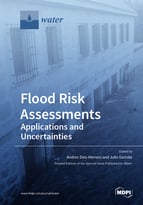Flood Risk Assessments: Applications and Uncertainties
A special issue of Water (ISSN 2073-4441). This special issue belongs to the section "Water Resources Management, Policy and Governance".
Deadline for manuscript submissions: closed (31 December 2019) | Viewed by 86178
Special Issue Editors
Interests: flood risk analysis; natural hazards mitigation; flood hydrology; paleohydrology; dendrogeomorphology; fluvial geomorphology; landscape and urban planning
Special Issues, Collections and Topics in MDPI journals
Interests: flood hazard; flood risk analysis; flood modelling; fluvial geomorphology; flash floods; LiDAR and photogrametry DEMS; PaleoFloods modelling; fluvial and terrain morphometry; beach and dune system erosion; coastal and shoreline process
Special Issues, Collections and Topics in MDPI journals
Special Issue Information
Dear Colleagues,
In recent years, a considerable volume of technical literature has been published on flood hazard analysis, and more recently on flood vulnerability and resilience. Nevertheless, there is still a shortage of scientific studies and practical experience of real flood risk assessment (both social and economic), including hazard, exposure and vulnerability analyses and their integration. As there are so few references available, applications of flood risk assessment to the design of preventive measures and early warning systems, landscape and urban planning, civil protection, insurance systems, and risk-based information and education, cannot reach their full potential development. This is because the research products available, such as hazard data and maps, do not serve to ensure the efficient prioritization of mitigation measures or communities at risk. Meanwhile, floods are the natural disaster that causes the greatest losses on a global scale, and due to climate change this situation is expected to continue.
The overall objective of this Special Issue is to improve our knowledge of data sources, methodologies and results, especially in analyses on a regional and local scale, from real flood risk assessments around the world. The final aim is to offer flood risk managers new tools, data and maps to improve risk mitigation, both preventive and corrective. Uncertainty analysis and its application to the process of flood risk analysis is of particular interest. Contributions to this Special Issue, showing successful experiences of flood risk analysis and applications, will undoubtedly be of considerable value both in an academic context and for flood risk managers. A wide variety of topics will be covered including: flood risk data sources; techniques and methodologies for flood risk analysis; cost–benefit analysis; flood risk mapping and cartographic representation of uncertainties; fields for the application of flood risk assessments; flood risk analysis calibrations; low-cost flood risk analysis in developing countries; or the interaction of fluvial and coastal processes in the flood risk of coastal regions.
Prof. Andres Diez-Herrero
Dr. Julio Garrote
Guest Editors
Manuscript Submission Information
Manuscripts should be submitted online at www.mdpi.com by registering and logging in to this website. Once you are registered, click here to go to the submission form. Manuscripts can be submitted until the deadline. All submissions that pass pre-check are peer-reviewed. Accepted papers will be published continuously in the journal (as soon as accepted) and will be listed together on the special issue website. Research articles, review articles as well as short communications are invited. For planned papers, a title and short abstract (about 100 words) can be sent to the Editorial Office for announcement on this website.
Submitted manuscripts should not have been published previously, nor be under consideration for publication elsewhere (except conference proceedings papers). All manuscripts are thoroughly refereed through a single-blind peer-review process. A guide for authors and other relevant information for submission of manuscripts is available on the Instructions for Authors page. Water is an international peer-reviewed open access semimonthly journal published by MDPI.
Please visit the Instructions for Authors page before submitting a manuscript. The Article Processing Charge (APC) for publication in this open access journal is 2600 CHF (Swiss Francs). Submitted papers should be well formatted and use good English. Authors may use MDPI's English editing service prior to publication or during author revisions.
Keywords
- Flood Risk Assessment
- Flood Risk Mapping
- Risk Uncertainties Propagation
- Flood Mitigation Measures
- Flood cost-benefit index
- Flood Risk Calibration







